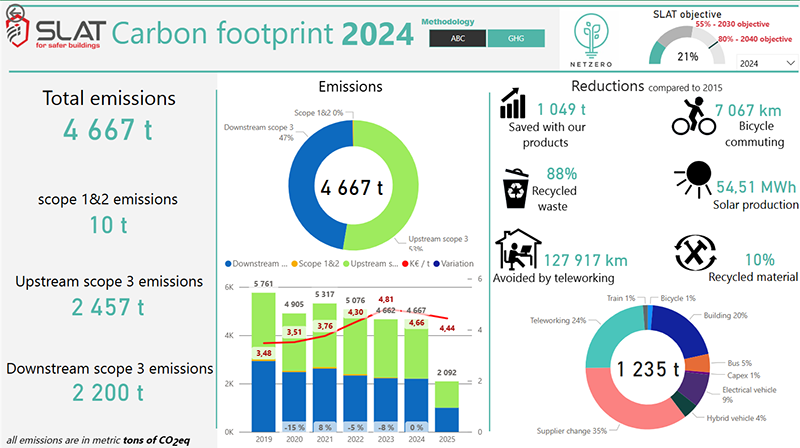Related subjects:
why act for the environment
Our concrete actions to reduce carbon footprint
The eco-design of our products, a benefit for our customers
Reducing our carbon footprint :
A yearly commitment of SLAT
The last year marked a decisive turning point in our journey towards sustainability and environmental responsibility. By adopting a holistic approach, we not only significantly reduced our direct emissions but also took ambitious steps to address the more complex aspects of our environmental impact, particularly those associated with scope 3. This article details our initiatives, learnings and future plans to reduce our carbon footprint.

Energy and Efficiency Transition
Our new building choice, which is among the most energy-efficient in the world, was one of our most strategic decisions of the year. Installing a heat pump instead of a gas-fired heating system in our old building has enabled us to significantly reduce our dependence on fossil fuels, with an annual reduction of 40 tonnes of CO2. This transformation is part of our commitment to minimising the direct impact of our activity (scope 1&2) on the environment, yet reduced to a mere 10 tons.
At the same time, the photovoltaic plant installed on our site has increased our capacity to generate clean energy, with more than 50 MWh produced during last year of operation. This initiative has not only halved our grid electricity consumption, but has also taken us a significant step closer to energy self-sufficiency. There is still room for improvement in synchronising the charging of employees' electric vehicles with peaks in solar production: a challenge that we are in the process of meeting, illustrating our desire to optimise every aspect of our energy consumption.
Scope 3 : Actions and prospects
Analysis of our carbon footprint has highlighted the very significant weight of indirect emissions associated with our activities (scope 3). In response, we have launched a number of strategic initiatives :
Scope 3 Upstream
A significant proportion of the company's upstream Scope 3 emissions come from the resources needed to manufacture its products. In particular, the use of metals for casings and electrical connections, but also petro-sourced plastics used in the manufacture of enclosures and boxes. Various initiatives have been launched to reduce the impact of our activity on the upstream scope 3 :
- Durability and Product Longevity : We have redefined the life expectancy of our products, increasing it from 10 to 20 years, twice the market standard. As well as reducing the need for replacement, this initiative is accompanied by a strong policy against obsolescence and for reparability, guaranteeing prolonged and responsible use.
-
Reuse and reconditioning : Experiments involving the reconditioning of end-of-life products aim to reintroduce into a cycle products that would otherwise be obsolete and destined for dismantling, giving these products a new life and reducing the need for new resources.
-
Researching and integrating eco-responsible materials : The transition to the use of recycled materials or materials with a lower environmental impact is one of our priorities. This approach is essential to reduce the impact of resource extraction, thereby contributing to a more virtuous value chain. In 2022, SLAT launched a range made entirely from recycled plastic. In 2023, the transport chocks were made from bio-sourced materials, considered as production waste from another sector. In 2024, We have almost eliminated all single-use plastics in favor of compostable or recyclable alternatives.
Scope 3 Downstream
The use of our products by customers is another important aspect of our environmental impact. To this end, we have put in place a number of measures:
- Improved energy efficiency : Our power supplies are designed to achieve the best possible energy efficiency, well above market standards, enabling our customers to save almost 1,100 tonnes of CO2 per year.
- Solar innovation : Recognising the inherent limits of energy efficiency, we are actively exploring the potential of solar energy to supplement or even power our products completely, further reducing their carbon footprint.
Towards a Sustainable Future
Our efforts are just further steps towards our ultimate goal of reducing our carbon footprint by 80% compared with 2015. Every initiative, every project and every innovation reflects our deep commitment to a more sustainable future. By taking into account every aspect of our environmental impact, from production to consumption, we are committed to a global and integrated approach.
Our journey towards sustainability is fraught with challenges, but also with immense opportunities. As a company, we remain committed to exploring all possible ways of minimising our carbon footprint, aware that our responsibility extends beyond our immediate operations, encompassing our entire value chain and the impact of our products on the world.
Related subjects:
why act for the environment
Our concrete actions to reduce carbon footprint
The eco-design of our products, a benefit for our customers
